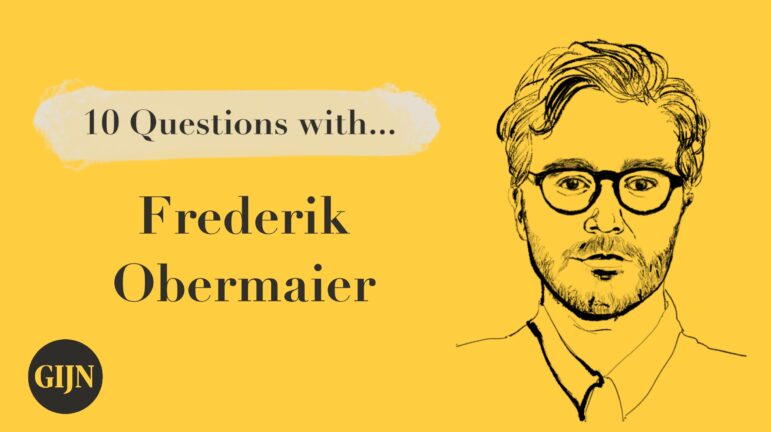

Image: GIJN
Gas Pipeline Sabotage, Cancer Cartels, Media Boys’ Clubs: 2023’s Best Investigative Stories in German
Collaboration has been the theme of the year. Investigative newsrooms working in German teamed up with peers, international partners, or local communities to investigate millions of documents, reconstruct catastrophes, or delve into structural problems. Whether using data and 3D modeling to dig into shipwrecks, going undercover to witness worker exploitation, or illuminating Russia’s clandestine influence in Europe, these examples of investigative journalism would not have been possible without collaborative efforts.
The trend towards teaming up in investigative journalism is a reason for optimism in a time of crisis for the media and press freedom, and the impact of watchdog journalism can be stronger when outlets consider each other allies, not competitors. These eight stories show the range of investigative approaches, the importance of collaboration, and how various formats can be employed to best tell a gripping story.
Crime Scene: Baltic Sea
When the Nord Stream gas pipelines in the Baltic Sea were the target of clandestine bombings in September 2022, global speculation over who was behind the sabotage was rife — but inconclusive. The pipelines are majority owned by Gazprom, Russia’s majority state-owned energy corporation. In the absence of clear evidence — and the challenge of finding clues 70 meters under water — this question has not been fully resolved.
This collaboration — involving several regional public broadcasters across Germany along with major newspapers Die Zeit and Süddeutsche Zeitung — examines the circumstances surrounding the blasts. To retrace the relevant sea routes, the team used the same sailing yacht that investigators believe may have been involved, and they dispatched divers to see if the boat’s involvement was feasible. They also talked to dozens of sources and analyzed scores of documents. The reporters came as close to an answer as they could with the information available — and produced a standout piece of investigative journalism that makes excellent use of reconstruction methods.
The project (Tatort Ostsee or ‘Crime Scene Baltic Sea’) is comprised of a five-episode podcast, a 36-minute documentary, and several articles explaining the main questions about the incidents. A thrilling example of a cross-newsroom, multimedia collaboration.
At the End of the Show
In June 2023, a team of reporters investigated a string of allegations of sexual misconduct and abuse of power by a member of a German rock band. The investigation, conducted by a collaborative team from Hamburg-based public broadcaster NDR and Süddeutsche Zeitung — who along with North Rhine-Westphalia broadcaster WDR have an investigative partnership — featured the testimony of several alleged victims. It was subsequently picked up by various other media. After publication, other alleged victims came forward.
The reporting led state prosecutors to open an investigation into alleged sexual offenses and drug distribution. However, the case was ultimately dropped, in part because officials stated there was insufficient evidence, and that law enforcement did not have direct testimonies from the victims.
This high-profile story sparked a debate in German media about how best to report on situations including sexual abuse and harassment claims. Overall, this investigation was a masterful example of what, in Germany, is termed “suspicion reporting” — based on a legal doctrine that sets out criteria for covering allegations with which journalists must comply, such as making readers aware that a subject could be innocent, and giving them ample time to respond.
Inside Tesla
A team at Stern Investigativ reported on the Tesla manufacturing plant in the German state of Brandenburg, the first location in Europe to produce the company’s electric cars.
This prestige project — one of Tesla’s Gigafactories — was built just east of Berlin. Its construction plans had drawn criticism for their potential environmental impact, but Stern’s investigation ventured further. Journalists went undercover by taking jobs at the plant and reported on adverse working conditions, abuse of workers’ rights, and pollution of the surrounding area. They supplemented the investigation with leaked documents and testimonials from sources, and published their reporting in a five-episode Inside Tesla podcast. A strong work of undercover reporting, backed up by evidence and told in a captivating narrative that the podcast format suits so well.
Tesla has rejected claims in media, and by a German union, that health and safety standards at the plant were inadequate, and stated that protecting workers’ health was a top priority.
Cyprus Confidential
An international collaboration — initiated by the Munich-based investigative newsroom Paper Trail Media, led by ICIJ, and featuring 67 other media partners — reveals that Cyprus plays a far larger role than was known in enabling networks of illicit investments, shielding wealth, and moving money for authoritarian leaders, oligarchs, and other anti-democratic actors, often in ways designed to elude sanctions. It also sheds light on Russia’s clandestine influence in European countries and the Cypriot and international entities that enable it.
Reporters on this sprawling cross-border project obtained leaked documents detailing financial transactions that Russian oligarchs and others have made through firms, banks, or other entities based in Cyprus. The dataset focuses on Cypriot firms that have become a haven for dirty money by providing offshore services, passports, or legal help. Reporters investigated around 3.6 million documents — a vast trove of evidence rendered manageable through this large collaboration. The investigation is comprised of several articles published nationally and internationally that each focus on specific facets of the leaks. For German audiences, perhaps the biggest scoop was that a prominent German journalist received a payment of US$600,000 from close Putin allies.
Reconstructing a Catastrophe at Sea
In June 2023, the Adriana, an overloaded fishing trawler carrying migrants from Libya on their way to Europe, sank 50 miles off the coast of Pylos in southwestern Greece, killing over 600 people — the deadliest Mediterranean shipwreck in years. The engine had faltered four days before the vessel issued a distress call; shortly after, it capsized and sank — exactly why and how is unclear without visual evidence.
A team of reporters for the video-format STRG_F (named for the German keyboard command for “search and find” which is produced under partnership between public broadcasters NDR and ZDF) teamed up with the Guardian, Forensis, and Greek media lab Solomon to investigate. The reporters conducted interviews with survivors, witnesses, and coast guard crew and trawled court documents; Forensis created an interactive 3D model to reconstruct events and map the final hours using maritime traffic data, satellite imagery, and video footage. Among other findings, their research into the ship’s final movements reveals inconsistencies in accounts from the Greek Coast Guard and EU border agency Frontex. This multi-faceted, cross-border investigation won several awards — including the 2023 Daphne Caruana Galizia Prize for Journalism.
Day Care Crisis
This investigation looks into a system failing society’s most vulnerable: children. With Crowd Newsroom, a community-driven investigation tool, the nonprofit outlet CORRECTIV took a deep look at the chronically underfunded and close-to-collapse children’s day care centers — known as Kitas — in Germany.
By analyzing documents the reporters obtained in collaboration with FragdenStaat — “Ask the State,” a right-to-information NGO — and comparing information from the documents with more than 1,000 testimonies from Crowd Newsroom, the investigation revealed that a large number of children don’t receive what can be described as day “care” at all, but rather an inadequate form of minding. Many day care centers have had to shut down due to staff shortages as employees suffered burnout. Testimonials from teachers and parents include shocking experiences — and children bear the brunt of the system’s failings. CORRECTIV’s investigation is an example of how community-driven journalism can help tell a story in ways that mere documents can’t.
The Cancer Cartel
Sometimes one needs a whistleblower to kick off an investigation. In this case, a pharmacist reached out to the investigative team at Monitor, a political TV program produced in partnership between Süddeutsche Zeitung and broadcasters WDR and NDR. The pharmacist told reporters that at least two oncologists had demanded a payoff from the pharmacy for chemotherapy medication their offices had prescribed. The system that underpins this practice allows only a few pharmacies to give out the expensive medication, and doctors choose to whom they will send prescriptions.
Cancer treatment, including chemotherapy, is a billion-dollar business, the reporters note. This investigation looks at the battle for lucrative prescription orders that can bring fat profits — or “pharmagold” — while the health system bears high costs, paid for by the insured. By researching price lists, reporters found that amounts that pharmacies charged for these medications far exceed what they should cost — according to their investigation, insurance companies could have saved at least €540 million (US$584 million).
The story resulted in several publications covering what became dubbed the “cancer cartel” — with various media outlets following patients, or attempting to trace where the money goes. Following the investigation, health insurers demanded structural change and the German health minister claimed there would be an investigation into the accusations.
Boys Club/Alleged Power Abuse
Two investigations, published months apart and employing different approaches, looked into allegations of abuses of power and sexual misconduct made against the former editor-in-chief of Germany’s highest-circulation tabloid.
Instead of chasing a scoop, these two investigations delved into the workplace culture that enabled a system where abuses of power went unchecked. Boys Club, produced by podcast company TRZ Media for Spotify, is an eight-episode narrative that extensively interviews dozens of current and former employees to explain the hierarchies, cult-like behavior, and sexist norms that flourish at the tabloid; Reschke Fernsehen, a political satire TV show on public broadcaster NDR, spoke to around 50 sources, also painting a picture of a longstanding, entrenched system at the tabloid’s parent publishing company. Their reporting yielded so many allegations that a lawsuit filed by the accused, who strenuously denies the claims, is still ongoing.
 Sarah Ulrich is GIJN’s German-language editor, overseeing GIJN Deutsch in cooperation with Netzwerk Recherche. She also works as an investigative reporter. Her work focuses on abuses of power, (labor) exploitation, right-wing violence, and feminist struggles.
Sarah Ulrich is GIJN’s German-language editor, overseeing GIJN Deutsch in cooperation with Netzwerk Recherche. She also works as an investigative reporter. Her work focuses on abuses of power, (labor) exploitation, right-wing violence, and feminist struggles.

















